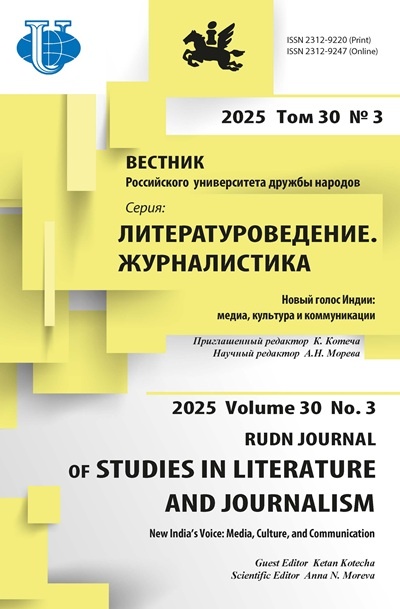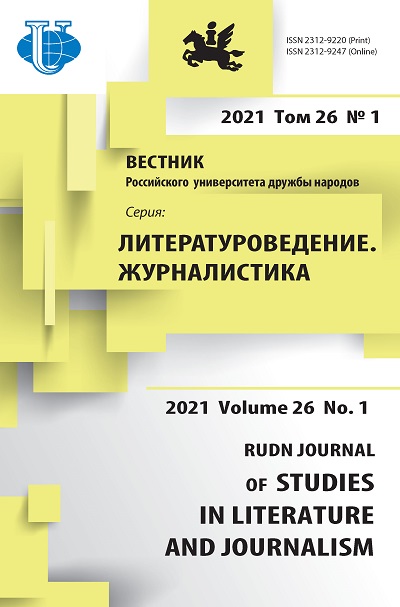Автобиографика «Моего обращения» Поля Клоделя
- Авторы: Банников К.В.1
-
Учреждения:
- Национальный исследовательский университет «Высшая школа экономики»
- Выпуск: Том 26, № 1 (2021)
- Страницы: 52-59
- Раздел: Литературоведение
- URL: https://journals.rudn.ru/literary-criticism/article/view/26076
- DOI: https://doi.org/10.22363/2312-9220-2021-26-1-52-59
- ID: 26076
Цитировать
Полный текст
Аннотация
Рассматривается автобиографика в творчестве Поля Клоделя на примере его программного эссе Ma Conversion («Мое обращение») 1913 г., написанного по просьбам его почитателей, считающих, что его биография более не принадлежит ему, поэтому опыт его обращения в веру должен стать всеобщим достоянием. Оно несет осознание и осмысление себя, перенесенные в последующие «биографические» художественные произведения. В нем сочетаются разные типы исповеди, проявляются черты проповеди, самовыражения, автобиографии. Язык произведения исполнен образности и многосмысленности. В клоделевском творчестве дистанция проявляется разными способами, от явного биографического автора - moi, Paul - до концепированного - le poète. Писатель начинает в исповедальной нерешительной манере, но по мере профессионального становления все меньше прибегает к «биографическому автору», оставаясь чаще в стороне в роли творца. В сборнике Conversations («Беседы», 1926-1937 гг.), где рефлексии все меньше, поэт рассуждает о действительности, но не описывает свои чувства и поступки, как делал это в молодом возрасте. Автобиографика П. Клоделя позволяет соединить в себе сакральное и профанное, в том время как интимное и публичное выступает в качестве «подготовительного» этапа к многотомному экзегетическому «роману».
Ключевые слова
Об авторах
Константин Валерьевич Банников
Национальный исследовательский университет «Высшая школа экономики»
Автор, ответственный за переписку.
Email: kbannikov@hse.ru
преподаватель департамента литературы и межкультурной коммуникации Нижегородского филиала
Российская Федерация, 603014, Нижний Новгород, Сормовское шоссе, д. 30Список литературы
- Lioure M. Claudel et l’Europe // Travaux de littérature. 1993. VI. Pp. 285-296.
- Claudel P. Oeuvres en prose. Gallimard, 1965. 1627 p.
- Гришин Е. В. Религиозная драма поля Клоделя: эстетика и творчество // Вестник ТГУ. 2007. № 4. URL: https://cyberleninka.ru/article/n/religioznaya-drama-polya-klodelya-estetika-i-tvorchestvo (дата обращения: 12.03.2020).
- Некрасова И.А. Поль Клодель и европейская сцена XX века: монография. СПб.: Изд-во СПбГАТИ, 2009. 464 с.
- Millet-Gérard D. Anima et la Sagesse: pour une poétique comparée de l’exégèse claudélienne. Paris: Editions P. Lethielleux, 1990.
- Millet-Gérard D. Claudel et Ivanov traducteurs d’Eschyle // Художественная реальность и литературный концепт: сб. материалов Международной научной конференции «Лингвистические основы международной коммуникации», 20-22 сентября 2007 г. Нижний Новгород, 2007. С. 73-84.
- Fumet S. Claudel. Gallimard, 1958. 252 p.
- Вера и личность в меняющемся обществе. Автобиографика и православие в России конца XVII - начала XX века: сборник статей / под ред. Л. Манчестер, Д.А. Сдвижкова. М.: Новое литературное обозрение, 2019. 408 с.
- Степина А.Н. Формально-содержательные модели литературной исповеди в книжности древней Руси // Вестник Российского университета дружбы народов. Серия: Теория языка. Семиотика. Семантика. 2012. № 1. С. 34-38.
- Бахтин М.М. Эстетика словесного творчества / сост. С.Г. Бочаров, примеч. С.С. Аверинцев, С.Г. Бочаров. М.: Искусство, 1979. 424 с.
- Grevisse M. Le bon usage. Grammaire française. 14e. éd. / refondue par A. Goosse. Paris - Gembloux: Duculot, 2008. 1322 p.
- Millet-Gérard D. Claudel-thomiste? Paris: Honoré Champion, 1999.
Дополнительные файлы















